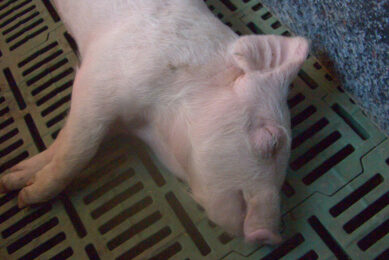Oedema disease – correct sampling is crucial

Oedema disease in weaned piglets is one of the most costly diseases in the rearing period. A study in Germany now shows that shigatoxin-producing Escherichia coli are more common than expected.
After separation from the sow, piglets are particularly susceptible to infections for many reasons: their maternal antibodies decrease and they often have to cope with feed conversion and other stressors (new environment, transport, ranking fights, etc.). In particular, infections with Escherichia coli (E. coli) occur more frequently. E. coli bacteria are found in the physiological intestinal flora of pigs, but some strains can produce toxins and thereby cause disease, either diarrhoea (enterotoxic E. coli) or oedema disease (shigatoxin-producing E. coli), depending on the pathogenicity factors of the strains – especially the attachment factors and toxins formed.
Oedema disease
The cause of oedema disease is ‘oedema disease E. coli” (EDEC), which contains the shigatoxin ‘stx2e’ and fimbriae of the type F18 for attachment to the epithelium of the pig’s small intestine. After attachment, EDEC produces the toxin stx2e, which is absorbed via the intestinal wall and thus enters the piglet’s circulation.
The toxin causes damage to small blood vessels in various organs. Oedemas in the brain lead to central nervous system failure symptoms (getting stuck and making running movements in a lateral position, sudden death), and oedemas on the head (eyelids, bridge of nose) are often visible. There is no adequate treatment for affected animals, because the toxin has already been absorbed when the clinical symptoms occur and it is therefore too late for antibiotic therapy. Due to the lack of treatment options, it is particularly important to prevent the occurrence of oedema disease through prevention strategies.
Diagnostic approach
A suspected diagnosis is possible based on clinical symptoms but must be distinguished from other conditions such as infections with Streptococcus suis or water deprivation. It therefore should always be confirmed by laboratory diagnosis consisting of cultivation of the bacteria from biological samples followed by a molecular biological examination via PCR.
Within the scope of the cross-sectional study, different biological sampling techniques for the detection of stx2e-encoding E. coli were tested and their sensitivity evaluated. Table 1 shows the advantages and disadvantages of faecal samples (picked up from the floor), boot swabs, and chewing ropes / saliva samples.
Prevalence of EDEC in Germany
In a German project, samples from 99 pig-producing farms with unknown infection status for EDEC were collected. On every farm, five pens of weaners (if available) were randomly selected for sampling, and in each pen five individual faecal samples (collected from the floor, at different locations) and two boot swaps (using socks) were collected. On 50 farms, one or two additional chewing ropes per pen were used, and oral fluids were collected from these chewing ropes. The researchers subsequently analysed the samples by bacterial culture and tested, using duplex-PCR, for the presence of both stx2e toxin and F18 fimbriae.
The samples collected showed that 23.2% of the pig-producing farms were affected by EDEC. That could be an underestimation of the true population prevalence of EDEC-infected farms with weaner piglets in the sampled population, since farms with low infection status could have been missed by the within-farm sampling approach.
A greater spread than previously assumed
Up to one third of German pig-producing farms could be affected by EDEC, which corresponds to a greater spread than previously assumed. To test for EDEC, it is possible to choose between rectal swabs, faecal samples and sock swabs. It is not recommended to exclusively test with chewing ropes.
Also, it is essential to make sure that a sufficient number of samples is taken. If the result is positive, the introduction of vaccination should be considered due to the high costs caused by losses. Because of increasing antimicrobial resistance, treatment of animal groups with antibiotics should not be an option in fighting oedema disease.
Authors
Pia Berger and Prof Marcus Doherr, Freie Universität Berlin
Steffen Hermanns and Prof Rolf Bauerfeind, Justus-Liebig-University, Giessen, Germany
 Beheer
Beheer









 WP Admin
WP Admin  Bewerk bericht
Bewerk bericht